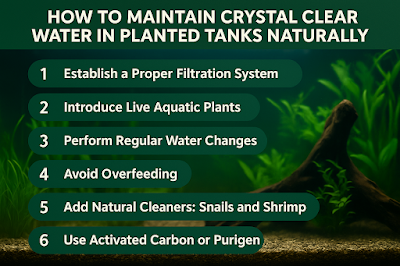Maintaining crystal clear water in a planted tank is not just about beauty—it's a reflection of a healthy aquatic environment. Many aquascapers aim for pristine clarity to highlight the plants and fish, but achieving this naturally requires a consistent, balanced approach. Fortunately, by following a few key practices, you can ensure your aquarium water stays clear without the need for chemicals.
The first step is investing in a high-quality filtration system. A good filter removes physical debris and hosts beneficial bacteria that break down harmful substances like ammonia and nitrite. Canister filters or sponge filters with layered media work best in planted tanks. These biological filters create a stable nitrogen cycle that supports overall water quality.
Live plants play a crucial role in natural water purification. Fast-growing species such as Monte Carlo, hornwort, or Amazon sword absorb excess nutrients that would otherwise encourage algae growth. By adding more greenery to your tank, you naturally balance nitrate levels and improve oxygenation, all of which contribute to water clarity.
Regular water changes are another vital routine. Replacing 20–30% of your tank’s water weekly helps dilute dissolved organics, phosphates, and tannins. Be sure to treat tap water with a dechlorinator before use. This simple habit prevents buildup of substances that cloud water over time.
Overfeeding is a common cause of cloudy tanks. Uneaten food decomposes quickly, releasing ammonia into the water. Feed your fish only what they can consume within a few minutes, once or twice per day. Also consider adding natural cleaners like Amano shrimp or Nerite snails, which help reduce algae and waste.
For extra clarity, some aquarists use activated carbon or Purigen in their filters. These materials remove discoloration, odors, and microscopic particles without harming plants or fish. However, when paired with a well-planted and balanced tank, you may not need these additives at all.
Ultimately, clear water is a result of consistency and care. When biological filtration, plant health, and maintenance work in harmony, your tank remains clean, balanced, and visually stunning—just as nature intended.
Keeping your aquarium water crystal clear is a top priority for every aquascaper. Cloudy water not only diminishes the aesthetic appeal of your tank but also indicates potential imbalances in your aquatic ecosystem. While chemical solutions exist, the best way to ensure consistently clear water is through natural, long-term practices that support both plant and fish health.
1. Establish a Proper Filtration System
A high-quality filtration system is the foundation of clean water. Using a canister filter or sponge filter with biological and mechanical media helps trap debris and supports beneficial bacteria growth. These bacteria break down waste products, reducing the risk of ammonia or nitrite spikes that can cloud the water.
2. Introduce Live Aquatic Plants
Live plants play a significant role in water clarity. Fast-growing species like Hornwort, Amazon Sword, or Monte Carlo absorb excess nutrients that would otherwise fuel algae growth. Plants also produce oxygen and stabilize pH levels, contributing to a healthier and more balanced environment.
3. Perform Regular Water Changes
Routine water changes are essential for removing dissolved waste and excess nutrients. Changing 20–30% of the water weekly helps dilute toxins and maintain mineral balance. Always use a water conditioner to neutralize chlorine and chloramine in tap water before adding it to the tank.
4. Avoid Overfeeding
Overfeeding fish is one of the main causes of cloudy water. Uneaten food decomposes, releasing ammonia and encouraging bacteria blooms. Feed only what your fish can consume within two minutes, and consider feeding once or twice daily for optimal cleanliness and health.
5. Add Natural Cleaners: Snails and Shrimp
Adding algae-eating species like Amano shrimp, Nerite snails, or Otocinclus catfish can help maintain a clean substrate and reduce algae buildup on glass and plants. These natural cleaners are peaceful and highly effective in a planted tank environment.
6. Use Activated Carbon or Purigen
If needed, natural filtration can be enhanced with activated carbon or Seachem Purigen in the filter. These materials help remove organic waste, tannins, and microscopic particles that cloud water, without affecting plant health or releasing harmful chemicals.
7. Consistency is Key
Clear water doesn’t happen overnight. It’s the result of consistent care, routine monitoring, and a well-balanced aquascape. Regular maintenance combined with live plants, beneficial bacteria, and responsible feeding will naturally lead to sparkling, healthy water that showcases your aquascape at its best.



.jpg)